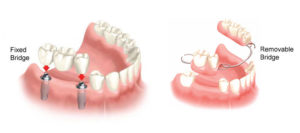If you’re missing one or more teeth, you’re not alone. The American Dental Association reports that average adults between 20 and 64 years old have three decayed or missing teeth. Fortunately, you have multiple options for replacing these missing teeth, including dental bridges. Here are four types of dental bridges that your dentist may recommend.
1. TRADITIONAL DENTAL BRIDGES
Traditional bridges are the most popular kind of bridge. These bridges consist of one or more pontics (fake teeth) and are held in place by dental crowns. These dental crowns are also called abutments, and they are cemented onto the teeth adjacent to your missing tooth.
Traditional bridges can be used when you have natural teeth on both sides of the gap created by your missing tooth. Bridges are even strong enough to replace molars. The downside of traditional bridges is that your dentist will need to prepare the adjacent teeth by removing their enamel to make room for the crowns that will be cemented on top. Since enamel doesn’t grow back, these teeth will always need to be protected with crowns, even if you later choose a different type of bridge.
2. CANTILEVER BRIDGES
Cantilever bridges are another option for replacing missing teeth. They are very similar to traditional bridges, but the pontic is supported by an abutment on only one side, rather than on both sides. So if there’s only one natural tooth next to the gap, a bridge can still be secured.
Like traditional bridges, your dentist will need to prepare the adjacent tooth to support the bridge by removing its enamel. Because these restorations are only supported on one side, they may act as a lever in some cases, explains the National Institutes of Health (NIH). This may lead to complications like fractured teeth or loosened crowns.
3. MARYLAND BRIDGES
Maryland bridges are considered a conservative alternative to traditional bridges. These bridges consist of a pontic that is held in place by a metal or porcelain framework. This framework is bonded onto the backs of the two teeth adjacent to the missing tooth. Since this type of bridge isn’t held in place by crowns, the adjacent teeth don’t need to be filed.
While Maryland bridges are more conservative than traditional bridges, they do have their downsides. The strength of the bridge is limited by the strength of the resin that holds it in place, so it may not stay in place in areas of the mouth where the teeth are subjected to a lot of biting force, like the molars. The framework may also get in the way of your gums or your bite.
4. IMPLANT-SUPPORTED BRIDGES
Implant-supported bridges are another option for replacing missing teeth. They can be used when you have more than one tooth missing. Instead of being supported by crowns or frameworks, these bridges are supported by dental implants. Usually, one implant is placed for every missing tooth, and this series of implants holds the bridge in place. However, the bridge may consist of a pontic suspended between two implant-supported crowns if placing one implant for every lost tooth isn’t possible.
The Dentists on Bluemound can close the gaps in your smile with dental bridges. With so many types of dental bridges available, you can feel confident that The Dentists on Bluemound can make your smile something to be proud of.





